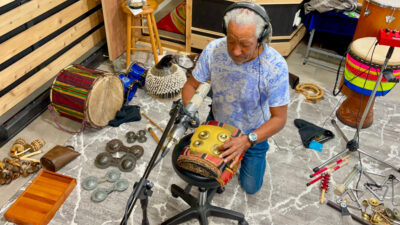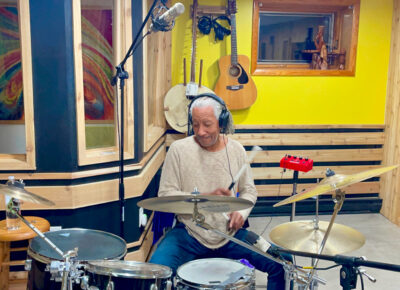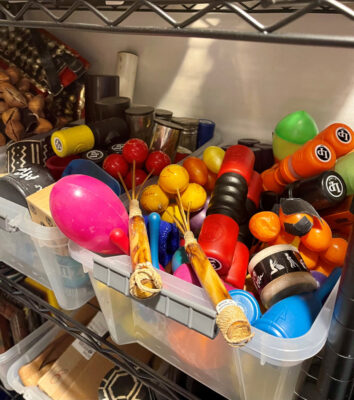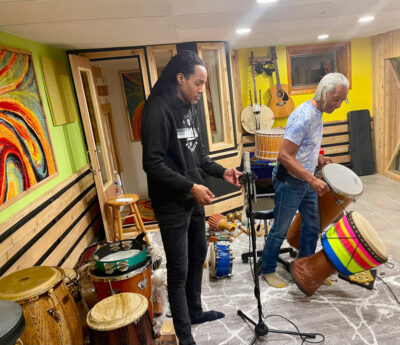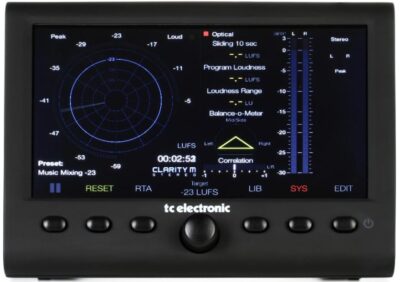Recording and Mixing Percussion: Bashiri Johnson’s Elite Techniques
It’s easy to learn from Bashiri Johnson – you just have to make contact.
Fortunately, making an instant connection with this master percussionist is simple: All you have to do is listen to his music. You’ll find him everywhere, recording or performing with royalty the likes of Beyoncé, Donald Fagen, Madonna, Rolling Stones, Paul Simon, Ray Charles, Jay Z, Whitney Houston, Michael Jackson, Aretha Franklin, Sting, Queen, and many more platinum artists.
His new album, A Better Way, Vol. 1, released as Bklyn Global takes your training even further. Thinking simultaneously as a producer, songwriter, and performer, Johnson made sure that the record’s nine tracks are relentlessly upbeat, percolating with positive vibes and addictive rhythms.
In August of 2017, SonicScoop visited Johnson at his Brooklyn recording studio, where he traded riffs and wisdom with reggae rhythm legend Larry McDonald. With the release of A Better Way, Johnson once again freely shares his incredible insights on how to record percussion and how to mix percussion.
“Art creation is a journey,” observes Bashiri, from his recently opened studio in upstate NY. He drew inspiration from top producers while recording A Better Way, including Phil Ramone, Kashif, The Neptunes, Nile Rodgers, Arif Mardin, Jellybean Benitez, Tom Lord-Alge, Neil Dorfsman, and more.
Calling the new record a work that “rings from my heart, soul and imagination,” Johnson saw its creation as mission critical. “My project, A Better Way, for me is not just an album, but more importantly a mindset,” he says. “I believe wholeheartedly that we all would like to experience and enjoy every bounty the planet has to offer in fairness, peace, and understanding. A Better Way is my proposal for global awakening and change.
“This record is a more collaborative offering than what I’m used to,” he continues. “Even though I wrote, co-wrote, played, programmed, and produced on all tracks, it was very special to work with Nya and Metric Man. The three of us make up Bklyn Global. It felt good to be in the company of uber-talented collaborators like them.”
The percussion performances throughout the record are fantastic, but Bashiri equally enjoys taking a deeper role as producer. “I’ve been blessed to observe and learn production from every producer I’ve shared space with throughout my recording career,” he says. “I have had the blessings of spending quality studio time with the likes of Phil Ramone, Kashif, The Neptunes, and on and on. As well as studying my favorites like Trevor Horn, Mutt Lange, Quincy Jones, Phil Spector, and everything Motown.”
“I’m Your Lioness” is a massively moving track built on stirring vocals and surging rhythms — an epic journey in just 2:41. “For me production starts with the why, and the story: ‘Why am I making this record, and what stories do I want to tell?’” Johnson explains. “I’ve never made a record with the intention of financial gain. Projects I produce are offerings from my heart, soul and imagination. I’ve learned that most every art creation is a journey, with a through line, to transport you from one state, thought, or emotion, to the next – ultimately to a place where you can experience the art personally.”
Brooklyn-based engineer and producer Darren Moore recorded Johnson throughout A Better Way, and was the mixer for “Lioness”. The new record benefits from Moore’s deep experience working with Johnson, an adventure spanning nearly 20 years.
“As a recording engineer working with Bashiri is a blessing,” Moore says. “For all the rancor of using technology and making it work in the arts, at the end of the day, it always lands on, ‘Can you perform?’ If not, we can make a good performance with tech tools – like lining up to the grid, or fixing tuning or tone — but that takes away from the getting-the-thing-out part.
“From a perspective of the lineage, Bashiri has worked and played for legends. Legends who relied on him to perform classic African and world percussion for modern records – so his timing and tone and use of the instruments is impeccable. Bashiri is familiar with styles and techniques, time-tested, from around the world. He has an impeccable sense of timing and can critique a performance with this canon of knowledge.”
How “I’m Your Lioness” Was Produced
The percussion for “Lioness” was conceived and arranged after the drums were recorded. Johnson had originally planned to play the drums himself, but decided his friend Rich Mercurio was the better choice.
“Rich has a genuine sense of the ‘epic’ vibe I was after and played amazingly for this track,” says Johnson. “I added the perc as overdubs after all the instruments and vocals were done. Darren Moore is mixer extraordinaire, so I never have to worry about things sounding the way they should. Darren and I are truly on the same page for tracking and mixing.
“This track has so many musical things going on, that I deliberately chose to have the perc seamlessly blend, as opposed to being a prominent feature. My general ‘default’ perc blend is to be tucked in the mix – not obtrusive or distracting. As for perc volumes, I like to play and rock ‘to’ the drums, not ‘on top’ of the drums.”
One of Moore’s favorite microphones for A Better Way was a stereo mic he loves – although he’s keeping its identity under wraps. “It’s a good mic: clean, clear, well tonally-balanced,” he says. “That makes it easy. When we’re tracking, remember that Bashiri will play about five to twelve different instruments, with that many performances. So, the mic needs to be versatile.
“We also experiment with the various mic preamps we have in the UAD Unison environment. We have landed on one very good microphone – secret for now – but remember, a good mic and preamp is the crux of recording instruments, even with modern technology. So, a good mic allows us to go from instrument to instrument with just adjusting the preamp and getting a good clean tone for the recording.”
Three Techniques for Recording Percussion
“My mission and service to the music,” Johnson says, “ultimately is to encourage, inspire, and excite the listener to dance, feel good, look inward. Above all else, want to hear and enjoy that record again, and again, and again.”
Here are three professional tips for recording percussion from top percussionist Bashiri Johnson.
Technique 1: Percussion Air
I like to give the perc instrument I’m recording some “air”, meaning not-too-close micing. You’ll usually never find me closer than 12 inches to the mic, there’s so much sonic nuance my instruments create in the room. They could be missed if I’m too close.
Technique 2: Find the Rhythms’ Place
I like to find my place in the record sonically, that augments and glues the groove together. That glue could be as simple as an egg shaker, or a complex combination of wood, glass, metal, and skins. My approach is to be fluid and synched, with the ebb and flow of the music.
Technique 3: Choose the Right Percussion Instruments
Instrument choice, and sonic selection is very important to me. As an example, see a pic of just one of many tubs of tambourines and shakers in my studio that I choose from.
Not every instrument is gonna sound great on any track. I try my best to choose emotionally and wisely. The perc instrument has to make me feel good playing it in the track, and it has to sound good in the blend of the mix, without getting lost at low volumes, or becoming a distraction at a louder volume.
Part II: Mixing Percussion Techniques and Tips
An in-demand producer, mixer, and engineer, Darren Moore mixed “I’m Your Lioness” with a clear understanding of Johnson’s vision for how percussion should fit into a mix. “Like other pros that I work with, he does not want to hear the ‘Demo’ until he is ready to actually record,” notes Moore. “Meaning, all the prep I find I need to do happens when he’s out of the room.
“So, the approach to the perc is simple:
- Tasteful – not too loud but present
- Fitting of the style – how other perc sections sound in the genre
- Authentic – we all kind of know what this means!
“So really, knowledge of styles and genres, plus having good taste, and bang – there you are. Then when we mix – and it’s a luxury to be in the recording and production stage to set all of this up – it’s just perspective, related to style and genre. Then taste, how spicy or stoic do you want it?
“Mixing techniques for ‘I’m Your Lioness’ were just developing the sensibilities needed. If you have the sensibility and sensitivity to realize what you need to put into the mix, then you’re able to make great records from great performances.”
Following are five invaluable percussion mixing tips from Darren Moore:
Technique 1: Percussion Recordings!
This is the best chance you have to make a great record. Again, I have been blessed to be in the mix from the inception (for “Lioness”). Being there when decisions are being made helps.
Yes, we use a really cool and magical microphone. It’s a stereo microphone and that’s a big plus. But capturing the performance and sound of the instrument is special. The intention of the performer and the ability to have it come in proper helps. I’m lucky to be a NYC music production engineer to understand that this is what it’s about.
Bash and I have been together on hundreds of sessions. So, I know how to record him. Bashiri will put down five to twelve-plus performances on various instruments. One after the other so I must stay sharp, and have a plan to capture at this pace so that the artist can play, and know we have it all.
Choose a good mic, put it in the proper place – use your ears to find this. Any extra luv (reverb, tone shaping or “magic”) to put in their ears also helps. Be the “help” for the task and you will have a great project to mix.
Technique 2: Mic and Preamp!
A good mic and preamp setup is the trick. Choose wisely. Dynamic, condenser, ribbon? We mostly lean on a good condenser. Large diaphragm, high SPL (sound pressure level).
A note here on gain stage and pads: Some drums and other percussion instruments have very loud transients, so a mic right up on the sound source may need a pad. -10 dB is sufficient. This is so you don’t have overs at the mic’s electronics.
The engineer also needs to mind these levels further down the signal chain, like the mic preamp and input to whatever is next. Good mics can handle high SPL, but even that can be exceeded by some sounds.
Technique 3: How to Use Compression to Mix Percussion, Instead of EQ
Well, here we go: I am one to lean more on compression than EQ for tone shaping. Also, EQ in the box is so special and surgical. But compression can be elusive, subtle, and effective.
The main three flavors (Optical, FET, or Vari Mu) need to be learned and applied well.
Optical (a.k.a. OPTO) is a slow attack and juicy tone especially in the low end.
FET (Field Effect Transformer) is fast and snappy – great for snares and other fast transient sounds.
Then we have Vari Mu. Like a Fairchild. It’s versatile, looks ahead a bit (its magic) and settles dynamics well (good for final mix or a mix bus).
So, choose wisely. I often use the FET type on percussion, but the OPTO will fatten any sound up.
Technique 4: Use a Spectrum Analyzer for Mixing
This tool, the spectrum analyzer, I learned while working at a premiere music studio in Manhattan with the most elite engineers and mixers. Again, I was blessed to be able to look over their shoulder and listen, but also see the analyzer.
I took the spectrum analyzer for what it was worth. Gold! Having this visual helps to shape what you are hearing with what is scientifically there! I use the TC Electronics Clarity M. It shows me frequency and sound field. I can look at what tones are peaking, and it shows me the curve of the overall tone of the record. If it looks right and sounds right, that’s good.
This helps as we move from space to space and environment to environment. If there’s a tone that is overrepresented, we can think about what’s causing it and adjust that. But the speakers and room may not tell us this, especially if you’re new in that space. So, this tool has helped me mix records.
“I’m Your Lioness” was mixed between my home studio corner (little space in my NYC apartment) and a studio that I was affiliated with. The analyzer traveled with me and added to my understanding of what we were hearing and if the mix was fire or trash.
Technique 5: How to Set Up Aux Busses for Reverb
Again, I’m old school, so I usually use buses and aux sends for reverb. I’ll put an effect on a track insert if that’s what it needs, but for reverb I normally do an aux send and return. This helps create a cohesive space and common vibe for the sounds in a record.
I am blessed as I have great friends at TC Electronics and Audio Ease, so my main go-to verbs are the TC Electronics VSS3 and AltiVerb. Well, let’s back up: AltiVerb is the best for spaces and models of real-world gear we like.
So, I usually set up four sends:
- Two we call “music sends” – for more spatial and room/space feeling
- The other two we call “vocal sends” – for melodic vibes that need to be more present and juicy
I also pepper in delays. One long, one short (¼ and ⅛), and one we call “Vibe”.
I also like the TC Electronics 2290, which is what I used on “Lioness.” The TC 2290 is the premier digital delay line (DDL) for studios for all time. The way you can program it and design its tone and vibe is beyond all others. I recommend you pick it up, and really the stock Digidesign/Avid DDL and Dverb are clutch. But we fancy, and we use TC all day!
So, to break it down:
- I send through an aux bus to a reverb and blend that back into the mix.
- I have reverbs designated for “Music” and “Vocals” (always need to decide where what will go).
- I employ delays “Short,” “Long,” and “Vibe.”
- Then a few “Special” effects like flanger, pitch and you-name-it to add width and space.
Hoping that with all this we can make magic. And if not, we will find it. Abra Cadabra!
— David Weiss is an Editor for SonicScoop.com, and has been covering pro audio developments for over 25 years. He is also the co-author of the music industry’s leading textbook on synch licensing, “Music Supervision, 2nd Edition: The Complete Guide to Selecting Music for Movies, TV, Games & New Media.” Email: david@sonicscoop.com
Please note: When you buy products through links on this page, we may earn an affiliate commission.







